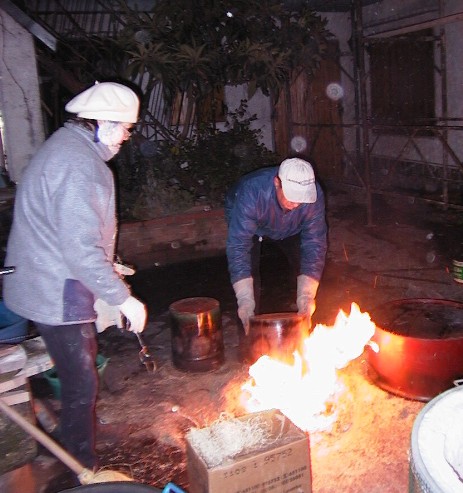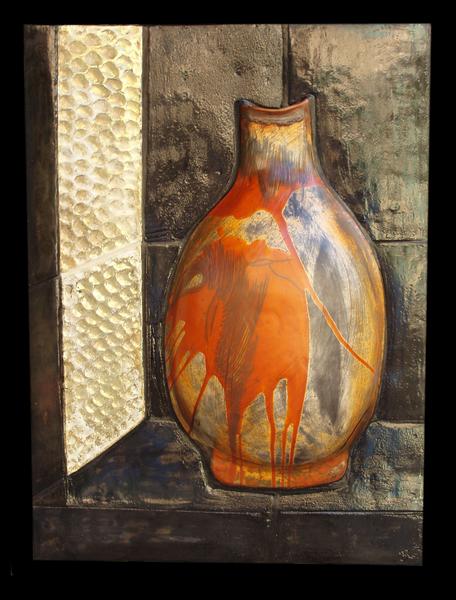RAKU - FORGING COURSES

Main menu:
TEACHER : FRANCA ROSSI
ELISA MARTINETTI
ALESSANDRA FARNETI
RAKU COURSE
BASIC
This is a basic course that wants to introduce beginners to this ancient Japanese technique, and therefore has the purpose to teach the manipulation and the shaping of everyday’s objects like tea cups, teapots, chawan, yakinuri etc.., according to the eastern ways.
Students will learn the ball technique, coil construction, slab technique and, possibly they will interact with the potter’s wheel.
After a first firing (bisque) , attention will be paid to the composition of the glazes, their application ( brush -
The highlight of the course will inevitably be the firing; in fact Raku is one of the few ceramic techniques that allows to immediately see a result, as the piece is removed from the kiln when the temperature reaches 1000 degrees, and then a particular treatment called " reduction " of the piece happens.
ADVANCED
This advanced course is addressed to those who already know ceramic and how to deal with it.
It will focus on shaping and especially on enamels, that will be prepared during the workshop.
Different types of firing and reductions ( with paper, leaves, manure, sawdust ) will complete the course.
ALTERNATIVE RAKU TECHNIQUES
This series of workshops is recommended for those who already own a discrete knowledge of ceramics.
RAKU SIGILLATO
During this workshop students will learn different techniques to compose a slip of terra sigillata, starting from the clay of Sapinecchio , then experimenting with other colored clays , until they will be introduced to sweet orange (Giovanni Cimatti’s sweet raku ) . Their application and firing will be the topics that we will face .
Terra sigillata is an ancient type of engobe , made from the decantation of clays, which we today place side by side to the Raku technique during the firing, thus obtaining interesting results.
NAKED RAKU
In this course students will learn the “splinting” of leather hard pieces, terra sigillata’s application, use of the detaching agent, enamels’s composition, the “naked” specific firing; this definition is used because after the firing, the coat of enamel separates from the piece, leaving it " undressed ", ie .. naked!
ENFUMAGE
In this course smoke is the main character, that runs over the piece, leaving traces and very unique designs.
In the first part students will deal with splinting, terra sigillata’s application and metallic oxides.
Hereafter we will focus on pit firing, saggar, hole firing and in manure pile. Amazing results are assured!!
BUCCHERO AND VILLANOVANS
This class is for all those who truly love Etruscan and proto Etruscan pottery.
The workshop will focus on the shaping of pieces, following the models of antiquity (patere, craters) and then splinting , terra sigillata , and reducing firing typical of that historic moment.
A RAKU’S WEEK: WORKSHOP
A “full immersion” week where we will be totally focused on Raku: from shaping to enamel painting and firing.
We will discuss the above said techniques, from the simplest to the most difficult ones.
Lessons about ceramics technologies and ideal kiln design for every participant.
In all courses the handmade pieces will be delivered to the students, along with specific handouts .
DURATION, TIMES AND PLACES
All the ceramic courses are addressed both to individuals and to groups.
The courses will last for about 20 hours (except for “full immersion” weeks) and they will be sorted in three days weekends or in more separate days, according to teachers and students availability.
The classes will take place inside and outside the workshops of Sapinecchio, house of art.
Equipment,materials and raw materials will be available to students.

Raku means to enjoy the day , to live in harmony with things and people . Raku originated from the name of the tea ceremony’s master Rikyu, lived in Japan in the sixteenth century. Tea ceremony was a very important event that involved costumes and philosophical thoughts of this community.
It seems that the characteristic of the Raku technique is due to a sixteenth century ceramist from the holy city of Kyoto. He produced tiles, and using the same technique he began to produce bowls of rounded shape without handles, so that they could be held between the fingers .
He then built a small kiln that allowed rapid cooking using the tiles’ s clay, rich of silica sand, which is refractory. When the market demand grew, he began to pull out the bowls from the kiln when they were still hot, using iron tongs; thus was accidentally born the raku technique. Over the centuries, Raku has been considered a new way of making ceramics at low temperature; the clay body has to be very refractory to allow the object to resist changes in temperature during the process of rapid firing (1h -
